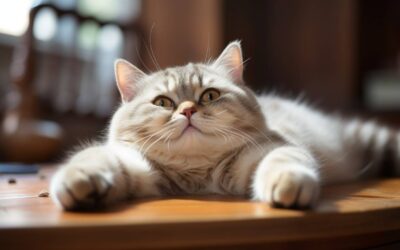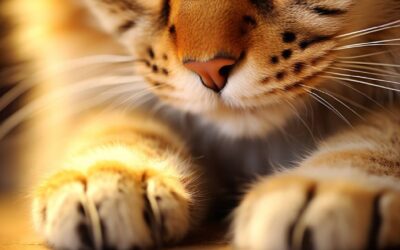One of the most intriguing aspects of cat nature is their penchant for pouncing and stalking. These behaviors are deeply ingrained in a cat’s instincts and are essential to understanding their world. This article will delve into why cats pounce and stalk, shedding light on this captivating aspect of feline behavior.
Why Cats Like to Pounce?
Cats’ fascination with pouncing can be attributed to innate instincts, evolutionary history, and unique sensory experiences. Here are the fundamental causes behind why cats like to pounce:
Predatory Instincts
The predatory pattern in cats is an ancient and integral part of their identity. These instincts have been finely tuned over thousands of years of evolution and survival in the wild. Understanding these instincts is crucial for comprehending why cats have an innate propensity to pounce and hunt.
- Evolutionary Heritage: Cats are descendants of solitary hunters, and their predatory instincts are deeply rooted in their evolutionary history. The ancestors of modern domestic cats relied on their hunting skills to secure food and survive in often challenging environments.
- Stealth and Ambush: Predatory instincts manifest in a cat’s ability to stalk, hide, and then suddenly pounce on prey. Cats are masters of stealth and ambush. They have acute senses, particularly their keen sense of hearing, which allows them to detect the slightest rustle or movement, a crucial skill for stealthy stalking.
- Hunting Techniques: Cats exhibit a range of hunting techniques, and these instincts play a role in their preference for pouncing. They may stalk low to the ground, mimic the movements of potential prey, and then spring into action with remarkable speed and accuracy. This behavior is not just about play; it mirrors their survival strategies in the wild.
- Toy Mimicry: Interestingly, when domestic cats pounce on toys or engage in playful hunting, they mimic their hunting techniques on inanimate objects. This provides an outlet for their instincts and a way to fulfill their hunting drive, even without natural prey.
Hunting Practice
Hunting practice is a fundamental aspect of a cat’s behavior and plays a significant role in shaping their physical abilities and mental acumen.
This practice, often observed through behaviors like pouncing, stalking, and mock attacks, serves several crucial purposes in a cat’s life.
- Refining Coordination and Reflexes: One of the primary reasons cats engage in hunting practice is to fine-tune their coordination and reflexes. Pouncing on moving objects or playfully stalking and chasing toys helps them develop exceptional agility and precision.
- Muscle Development: Pouncing requires multiple muscle groups in a cat’s body, including the legs, back, and abdominal muscles. Regular hunting play exercises these muscles, contributing to a cat’s overall strength and physical fitness.
- Stress Reduction: Engaging in hunting play can be a natural stress reliever for cats. It allows them to release pent-up energy and tension, promoting relaxation and well-being.
- Sense of Fulfillment: Successfully “capturing” a toy or playfully pouncing on a target can give cats a sense of accomplishment and fulfillment. It mimics the satisfaction they would derive from a successful hunt in the wild.

Mental Stimulation
Mental stimulation is a critical aspect of a cat’s overall well-being. While we often focus on physical exercise and nutrition, providing opportunities for mental engagement is equally important for our feline friends.
- Preventing Boredom: Boredom can lead to various behavioral problems in cats, such as destructive behavior or excessive vocalization. Mental stimulation effectively combats boredom by providing entertainment and mental challenges, reducing the risk of behavioral issues.
- Reducing Stress and Anxiety: Engaging a cat’s mind can help reduce stress and anxiety. Interactive play and puzzle toys can distract them from stressful situations or help them cope with environmental changes. Mental stimulation offers a healthy outlet for pent-up energy and emotions.
- Encouraging Playfulness: Cats are playful animals, and mental stimulation often takes the form of play. Play sessions that involve stalking, pouncing, and chasing mimic natural hunting behaviors and provide both physical and mental exercise. This type of play encourages a cat’s innate curiosity and exploration.
Incorporating mental stimulation into your cat’s daily routine is essential for their physical and mental health. Interactive toys, puzzle feeders, and regular play sessions are excellent ways to engage your cat mentally.
Scratching and Biting
In addition to pouncing, cats often exhibit scratching and biting behaviors during their playful episodes. These behaviors are closely tied to their predatory instincts and need to communicate and mark their territory.
Scratching is a way for cats to sharpen their claws and mark their territory. When they scratch a surface, they leave both a visual mark and a scent mark from glands in their paws. It’s their way of saying, “This is my space.” So, when your cat scratches your furniture or a scratching post, it’s a natural behavior driven by instinct.
On the other hand, biting can be a form of play, but it’s also a way for cats to communicate with their owners and fellow felines. When a cat playfully nibbles your hand, it shows affection and trust. However, your cat may be overstimulated or uncomfortable if the biting becomes aggressive.
Conclusion
Understanding why cats pounce and stalk is key to appreciating their complex and fascinating nature. These behaviors are not just about play; they reflect a cat’s innate instincts, honed through generations of hunting and survival.
So, the next time your feline friend pounces on a toy or stalks your shoelaces, remember that they are simply following their instincts, and it’s all a part of what makes them the unique and captivating companions they are.

FAQs
Why do cats like to pounce and stalk?
Cats pounce and stalk as a manifestation of their predatory instincts. It’s a behavior deeply rooted in their DNA, dating back to their wild ancestors.
Is pouncing on toys a form of exercise for cats?
Pouncing on toys or objects allows cats to stay physically active and mentally engaged. It helps them maintain their agility and reflexes.
Should I be concerned if my cat bites during play?
Mild biting during play is usually a sign of affection and trust. However, if biting becomes aggressive or painful, it may indicate overstimulation or discomfort.
Why do cats scratch furniture and other surfaces?
Cats scratch to sharpen their claws and mark their territory. It’s a natural behavior driven by their instincts.
Can I train my cat to stop scratching furniture?
You can train your cat to use a scratching post instead of furniture. Provide them with a suitable scratching post and use positive reinforcement to encourage the behavior.






This explains so much! Watching my cat stalk her toys is always entertaining. It’s fascinating how their instincts kick in, even indoors. Cats are mysterious little hunters.
Your article explained their natural behaviors so well! Do you have any tips for engaging indoor cats?
Do you think this behavior is purely instinctual or a mix of play and hunting?